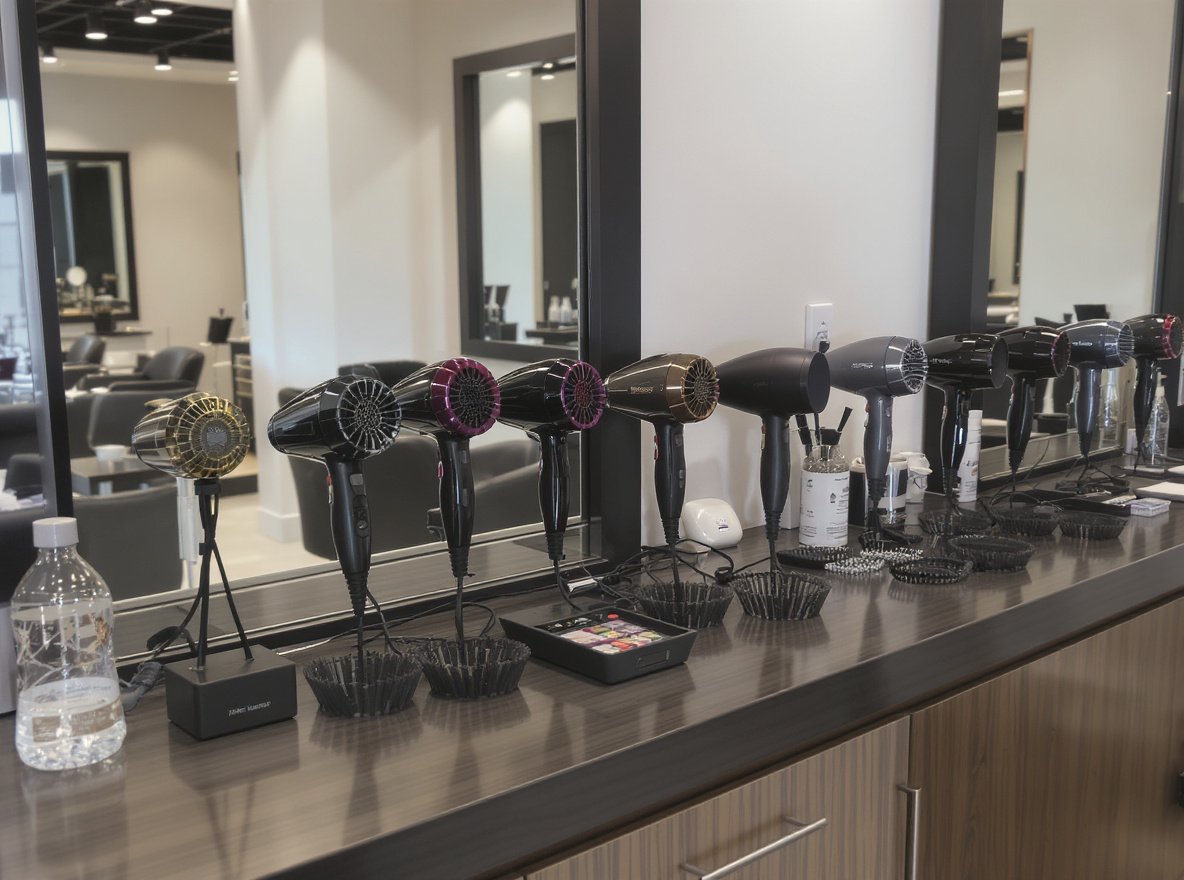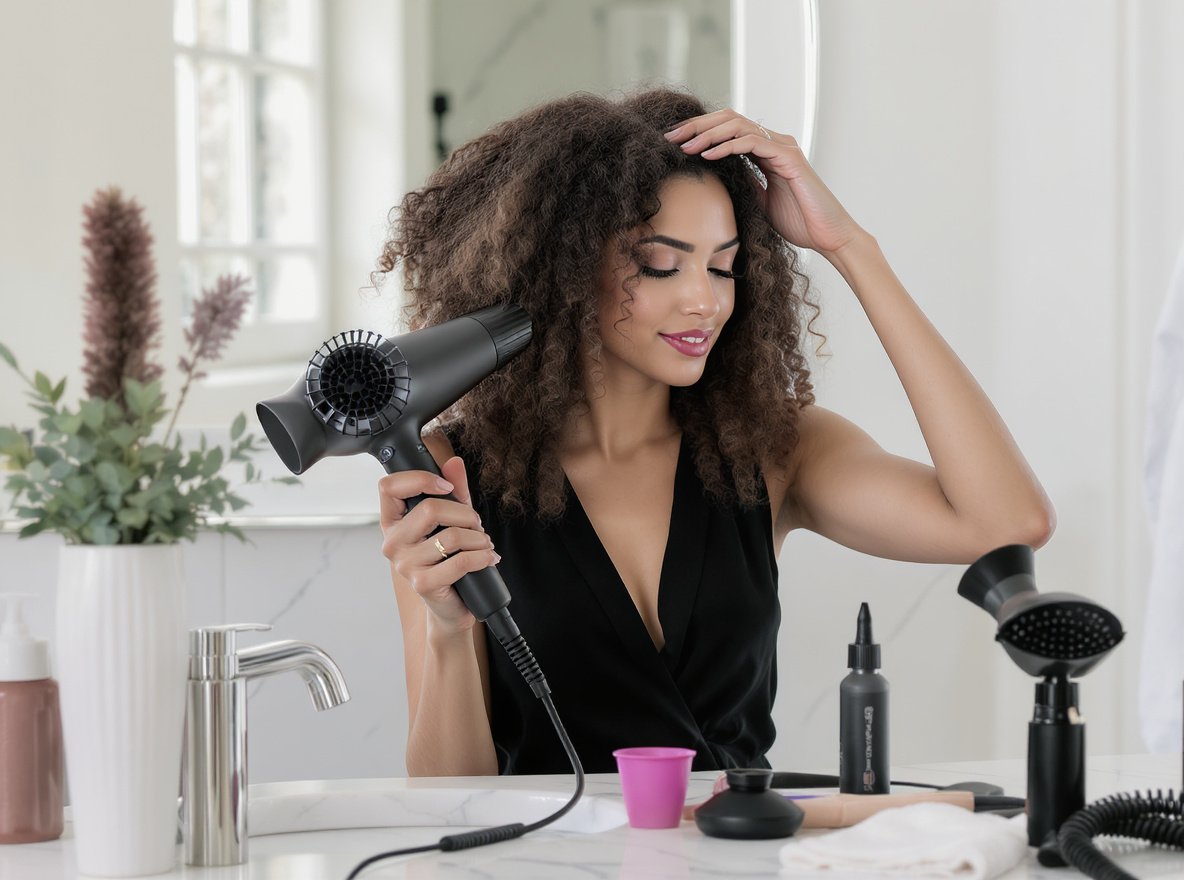Running a busy salon or managing wholesale hair dryer inventory, you’ve probably wondered about the hidden costs of different dryer settings. Every kilowatt matters when you’re calculating operational expenses and advising your retail clients.
Yes, a blow dryer on cold setting uses significantly less electricity than hot settings. Cold air typically uses only 300-500 watts compared to 1,500-1,800 watts on high heat – that’s up to 83% less energy consumption.
Understanding these power differences helps you make smarter purchasing decisions and provide valuable energy-saving insights to your customers.
Table of Contents
ToggleHow Much Electricity Does a Hair Dryer Actually Use?
Many wholesalers underestimate the power consumption variations across different dryer models and settings. This knowledge gap can impact both your inventory decisions and customer satisfaction.
A typical hair dryer uses between 1,500 and 1,800 watts when set to high heat, while travel-sized models may use as little as 1,000 watts and professional models can reach up to 2,000 watts.

The actual consumption depends on several factors that directly affect your wholesale considerations:
Professional vs Consumer Power Requirements
- High-end Professional Models: 1,800-2,000 watts for salon performance
- Standard Home Models: 1,500-1,800 watts for daily use
- Compact Travel Models: 1,000-1,200 watts for portability
- Low-power Efficient Models: 400-1,000 watts on reduced settings
Real Usage Cost Analysis
If your customers use a 1,500-watt dryer for 10 minutes daily, it consumes about 7.5 kWh per month, costing roughly $1.05 monthly at an average electricity rate of $0.14 per kWh.
For busy salons operating 8 hours daily with multiple dryers, monthly electricity costs can range from $180-350 depending on usage patterns and local utility rates.
| Dryer Type | Typical Wattage | Daily Cost (10 min) | Monthly Cost |
|---|---|---|---|
| Professional High-Heat | 1,800W | $0.042 | $1.26 |
| Standard Home Model | 1,500W | $0.035 | $1.05 |
| Energy-Efficient Model | 1,000W | $0.023 | $0.70 |
| Cold Setting Only | 400W | $0.009 | $0.28 |
Why Does Cold Air Use Less Power?
The science behind cold air settings reveals why they’re so energy-efficient. This understanding helps you explain the benefits to environmentally conscious retailers and cost-aware salon owners.
Cold air settings bypass the heating element—the component responsible for the majority of power consumption—and only operate the fan motor, which requires a fraction of the total wattage.

When you select cold air mode, several energy-saving mechanisms activate:
Heating Element Shutdown
The ceramic or wire heating elements completely turn off, eliminating the largest power draw. This represents 70-80% of total energy consumption in most hair dryers.
Motor-Only Operation
Only the fan motor continues running, typically consuming 300-500 watts compared to 1,500+ watts with heating elements active. Modern brushless motors in premium models are particularly efficient.
Optimized Airflow Systems
Quality hair dryers feature intelligent circuits that optimize power distribution. When heating elements aren’t needed, the entire electrical system operates more efficiently, maximizing airflow per watt consumed.
Real-World Energy Consumption Examples
Actual testing reveals significant variations in power usage that impact your wholesale calculations and customer recommendations.
Understanding these real numbers helps you position different models appropriately in your product lineup.
Based on comprehensive testing, hair dryers show dramatic power variations: high heat settings consume 1,440-1,800 watts, while cold air settings use only 300-500 watts.

Detailed Power Consumption Breakdown
- High Heat Setting: 1,440-1,800 watts (1.44-1.8 kW)
- Medium Heat Setting: 800-1,200 watts
- Low Heat Setting: 400-1,000 watts
- Cold Air Setting: 300-500 watts (similar to fan motor wattage)
Monthly Usage Scenarios
For a typical 10-minute daily usage pattern:
- High Heat (1,500W): 7.5 kWh/month ≈ $1.05/month
- Medium Heat (1,000W): 5 kWh/month ≈ $0.70/month
- Cold Air (400W): 2 kWh/month ≈ $0.28/month
Professional Salon Impact
High-volume salons with 6-8 dryers operating simultaneously can see monthly electricity costs ranging from $400-800 on high heat settings versus $80-160 using strategic cold air integration.
What Affects Hair Dryer Energy Consumption?
Multiple factors influence power usage, directly impacting your wholesale strategy and customer satisfaction levels.
Smart wholesalers understand these variables to recommend appropriate models for different market segments.
Wattage rating, heat settings, air speed, usage duration, model efficiency, and motor quality all significantly impact how much electricity a hair dryer consumes.

Primary Power Consumption Factors
Wattage Rating Impact
Higher wattage doesn’t always mean higher efficiency. Modern high-wattage dryers often dry hair faster, potentially using less total energy per styling session than lower-wattage models requiring longer usage times.
Heat Setting Variables
- High Heat: Maximum power draw for quick professional results
- Medium Heat: Balanced performance and efficiency
- Low Heat: Gentle drying with reduced energy consumption
- Cold Air: Minimal power for setting styles and energy savings
Usage Duration Considerations
- Fine Hair: 3-5 minutes average drying time
- Medium Hair: 6-10 minutes typical duration
- Thick Hair: 12-18 minutes required time
- Professional Styling: 15-25 minutes per client
Model Efficiency Features
- Advanced Motor Technology: Brushless motors increase efficiency by 20-30%
- Ceramic Heating Elements: Provide more even heat distribution
- Ionic Technology: Reduces drying time by 40-50%
- Smart Temperature Control: Automatically adjusts heat to prevent energy waste
Energy-Saving Tips for Hair Dryer Users
Educating your retail customers about energy conservation techniques creates value-added relationships and positions you as a knowledgeable supplier.
These practical tips help end users maximize efficiency while maintaining styling quality.
Using the cool air setting saves energy and protects hair health, while towel-drying first can reduce blow-drying time by 30-40%, directly cutting electricity usage.

Pre-Drying Optimization
- Towel-dry thoroughly: Remove as much moisture as possible before using the dryer
- Use microfiber towels: More effective moisture absorption than cotton
- Gentle patting technique: Avoid rough rubbing that damages hair cuticles
- Air-dry partially: Allow 10-15 minutes of natural drying when possible
Smart Setting Strategies
- Start with lower heat: Begin with medium settings and increase only as needed
- Use cold shots strategically: Finish with cold air to lock in styles
- Section hair properly: Dry hair in manageable sections for efficiency
- Maintain optimal distance: Hold dryer 6-8 inches from hair for best airflow
Maintenance for Maximum Efficiency
- Clean air filters weekly: Prevents airflow restriction and power waste
- Remove lint buildup monthly: Maintains optimal motor performance
- Check cord connections quarterly: Ensures proper electrical flow
- Professional servicing annually: Maintains peak efficiency and safety
How to Choose Energy-Efficient Hair Dryers for Your Business
Selecting the right models for your wholesale inventory requires balancing performance, efficiency, and market demand.
Smart buyers focus on features that deliver both immediate performance and long-term value for end users.
Look for dryers in the 1,200-1,600 watt range with advanced features like ceramic or tourmaline heating elements, intelligent heat control, and optimized airflow systems.

Essential Efficiency Features
- Wattage Sweet Spot: 1,200-1,600 watts provides optimal performance for most hair types
- Advanced Heating Elements: Ceramic and tourmaline offer superior heat distribution
- Intelligent Controls: Multiple heat and speed settings for customized efficiency
- Motor Technology: Brushless motors provide longer lifespan and lower energy consumption
Professional-Grade Considerations
When targeting salon markets, prioritize models with:
- Durability ratings: Proven longevity under heavy commercial use
- Energy certifications: Look for efficiency designations and eco-friendly credentials
- Performance optimization: Efficient drying without excessive heat reduces both energy use and hair damage
- Maintenance accessibility: Easy cleaning and servicing reduces operational costs
The Laifex P1C high-speed hair dryer exemplifies these professional standards, featuring advanced airflow technology and intelligent power management systems designed for both performance and energy efficiency.
Cost Analysis: Hot vs. Cold Settings
Understanding the financial impact of different settings helps you provide concrete value propositions to cost-conscious customers.
These calculations demonstrate real savings that appeal to both salon owners and energy-conscious consumers.
Switching to cold air settings can reduce hair dryer electricity costs by up to 75% compared to the highest heat settings, saving $40-60 annually for home users and $400-800 for busy salons.

Detailed Cost Comparison (10 minutes daily usage)
| Setting | Power Draw | Monthly kWh | Monthly Cost ($0.14/kWh) | Annual Cost |
|---|---|---|---|---|
| Hot/High | 1,500-1,800W | 7.5-9 kWh | $1.05-$1.26 | $12.60-$15.12 |
| Medium Heat | 1,000W | 5 kWh | $0.70 | $8.40 |
| Low Heat | 600W | 3 kWh | $0.42 | $5.04 |
| Cold Air | 300-500W | 1.5-2.5 kWh | $0.21-$0.35 | $2.52-$4.20 |
Professional Salon Economics
For salons operating 8 hours daily with 4 dryers:
- High Heat Strategy: $280-350 monthly electricity costs
- Balanced Approach: $180-220 monthly costs
- Cold-Emphasis Method: $90-120 monthly costs
- Strategic Integration: Saves $1,200-2,400 annually per salon
Return on Investment Analysis
Energy-efficient models typically cost 15-25% more initially but provide:
- 20-35% lower operational costs
- Extended equipment lifespan
- Enhanced customer satisfaction
- Improved environmental compliance
Industry Trends in Energy-Efficient Hair Dryers
The hair dryer market increasingly emphasizes sustainability and energy efficiency, creating opportunities for forward-thinking wholesalers.
Understanding these trends helps you anticipate customer demands and position your inventory strategically.
Modern consumers prioritize energy efficiency alongside performance, driving demand for dryers with optimized airflow, smart sensors, and lower wattage designs that maintain superior drying performance.

Revolutionary Technology Advances
- Optimized Airflow Design: Newer models maximize drying efficiency with reduced heat requirements
- Smart Sensor Integration: Advanced dryers feature sensors that adjust heat automatically to prevent energy waste and hair damage
- Low Wattage Performance: Technology advances allow lower wattage without sacrificing drying speed
- Eco-Friendly Materials: Manufacturers increasingly use sustainable materials and packaging
Market Demand Evolution
Current industry data shows:
- 67% of consumers actively consider energy efficiency when purchasing
- Professional salons target 30-40% energy reduction goals
- Government incentives support energy-efficient appliance adoption
- Eco-certification becoming standard market requirement
Wholesale Positioning Strategies
Position your business competitively by:
- Featuring efficiency prominently: Highlight energy-saving capabilities in product descriptions
- Providing consumption data: Supply detailed wattage and cost calculations
- Offering consultation services: Help customers calculate potential savings
- Partnering strategically: Align with eco-conscious beauty brands and green certification programs
Summary
Cold air settings on blow dryers use significantly less electricity than hot settings, with consumption dropping from 1,500-1,800 watts to just 300-500 watts – up to 83% reduction. This dramatic decrease occurs because cold settings bypass energy-intensive heating elements, using only the motor for airflow. Smart wholesalers can leverage this knowledge to help customers reduce operational costs by $400-800 annually while maintaining professional styling quality.
Ready to upgrade your hair dryer inventory with energy-efficient models that deliver both performance and savings? Browse our professional-grade collection at laifex.com and discover how the right equipment can transform your customers’ operational efficiency. Contact us today for wholesale pricing and detailed energy consumption specifications that help you serve your market more effectively.



